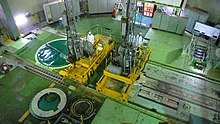Fast Breeder Test Reactor
This article needs additional citations for verification. (March 2017) |

12°33′44″N 80°09′52″E / 12.5623504°N 80.1645415°E The Fast Breeder Test Reactor (FBTR) is a breeder reactor located at Kalpakkam, Tamil Nadu, India.[1] The Indira Gandhi Center for Atomic Research (IGCAR) and Bhabha Atomic Research Centre (BARC) jointly designed, constructed, and operate the reactor.
History
[edit]Construction started in 1972 ad it first reached criticality in October 1985,[2] making India the seventh nation to have the technology to build and operate a breeder reactor after United States, UK, France, Japan, Germany, and Russia. The reactor was designed to produce 40 MW of thermal power and 13.2 MW of electrical power. The initial nuclear fuel core used in the FBTR consisted of approximately 50 kg (110 lb) of weapons-grade plutonium.
The FBTR has rarely operated at its designed capacity and had to be shut down between 1987 and 1989 due to technical problems. From 1989 to 1992, the reactor operated at 1 MW.
In 1993, the reactor's power level was raised to 10.5 MW. In September 2002, fuel burn-up in the FBTR for the first time reached the 100,000 megawatt-days per metric ton uranium (MWd/MTU) mark.[citation needed] This is considered an important milestone in breeder reactor technology. On 7 March 2022 it attained the design power level of 40 MWt.[2]
Using the experience gained from the operation of the FBTR, a 500 MWe Prototype Fast Breeder Reactor (PFBR) is in advanced stage of construction at Kalpakkam.[3]
Technical details
[edit]The reactor uses a plutonium-uranium mixed carbide fuel and liquid sodium as a coolant. The fuel is an indigenous mix of 70 percent plutonium carbide and 30 percent uranium carbide. Plutonium for the fuel is extracted from irradiated fuel in the Madras power reactors and reprocessed in Tarapur.
Some of the uranium is created from the transmutation of thorium bundles that are also placed in the core.[4]
References
[edit]- ^ "A creditable performance at Kalpakkam". Indira Gandhi Centre for Atomic Research. 19 October 2005. Archived from the original on 5 November 2009. Retrieved 25 March 2017.
- ^ a b "IGCAR: Milestones". Indira Gandhi Centre for Atomic Research. Retrieved 19 January 2023.
- ^ "Indian test reactor reaches operation landmark : New Nuclear - World Nuclear News". www.world-nuclear-news.org. Retrieved 10 January 2024.
- ^ "Press Release | February 27, 2013". Department of Science and Technology (India). 27 February 2013. Archived from the original on 22 March 2014. Retrieved 22 March 2014.
